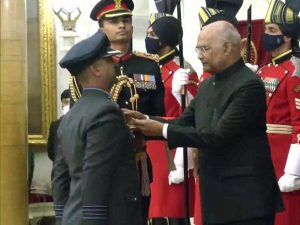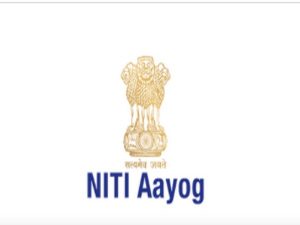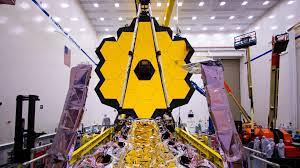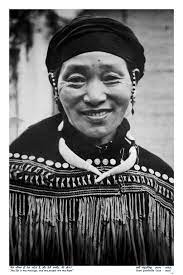Today Current Affairs: 25th November 2021 for UPSC IAS exams, State PSC exams, SSC CGL, State SSC, RRB, Railways, Banking Exam & IBPS, etc
Table of Contents
Gallantry Awards:

Group Captain Abhinandan Varthaman was awarded Vir Chakra which is a wartime gallantry award, by the President of India.
- The gallantry awards are announced twice in a year — first on the occasion of the Republic Day and then on the occasion of the Independence Day.
- Post-Independence, first three gallantry awards namely Param Vir Chakra, Maha Vir Chakra and Vir Chakra were instituted by the government of India on January 26th 1950 which were deemed to have effect from August 15th,1947.
- Thereafter, other three gallantry awards — the Ashoka Chakra Class-I, the Ashoka Chakra Class-II and the Ashoka Chakra Class-III — were instituted in 1952, which were deemed to have effect from August 15, 1947.
- These awards were renamed as Ashoka Chakra, Kirti Chakra and Shaurya Chakra respectively in January 1967.
People Eligible for the Awards:
- All officers of all ranks of the Army, Navy and the Air Force or of any of the reserve forces, territorial army and any other lawfully constituted armed forces.
- In addition to the above-mentioned personnel, matrons, sisters, nurses, alongside the staff of the nursing services and other services pertaining to hospitals and nursing and civilians, both male and females, serving regularly or temporarily under the orders, directions or supervision of any of the above-mentioned forces.
Wartime Highest Gallantry Awards:
Param Vir Chakra:
- It is India’s highest military decoration awarded for displaying distinguished acts of valour during wartime whether on land, at sea or in the air.
Maha Vir Chakra:
- It is the second highest gallantry award for acts of conspicuous gallantry in the presence of the enemy whether on land, at sea or in the air.
Vir Chakra:
- It is the country’s third-highest wartime gallantry award after Param Vir Chakra and Maha Vir Chakra.
SDG Urban Index: NITI Aayog

NITI Aayog under the Indo-German Cooperation released the inaugural Sustainable Development Goals (SDGs) Urban Index and Dashboard 2021–22.
- Earlier in June 2021, the third edition of the Sustainable Development Goals (SDG) India Index and Dashboard 2020–21.
- The index and dashboard are a result of the NITI Aayog-Germany’s International Cooperation Agency (GIZ) and BMZ collaboration focused on driving SDG localization in our cities, under the umbrella of Indo-German Development Cooperation.
- It ranks 56 urban areas on 77 SDG indicators across 46 targets of the SDG framework.
- It will further strengthen SDG localization and institute robust SDG monitoring at the city level.
- The urban areas are ranked on a scale of 0-100.
- A score of 100 implies that the urban area has achieved the targets set for 2030; a score of 0 implies that it is the farthest from achieving the targets among the selected urban areas.
- Overall or composite urban area scores are then generated from the Goal-wise scores to measure aggregate performance of the urban area.
- Urban areas have been classified as below based on their composite score:
- Aspirant: 0–49
- Performer: 50–64
- Front-Runner: 65–99
- Achiever: 100
Performance of the States:
Top Performers:
- Shimla, Coimbatore, Chandigarh, Thiruvananthapuram and Kochi.
Worst Performers:
- Dhanbad, Meerut, Itanagar, Guwahati and Patna.
What Are Radio-Collars?

Last week, a wild elephant was radio-collared for the first time in Assam’s Sonitpur district by the state’s Forest Department, in collaboration with NGO World Wildlife Fund (WWF)-India.
- The joint initiative is being described as a step to study and mitigate human-elephant conflict in the state.
- Experts say the exercise is challenging, and even runs the risk of having a low success rate.
- Radio collars are GPS-enabled collars that can relay information about an elephants’ whereabouts. They weigh roughly 8 kg and are fitted around the elephant’s neck.
- According to a WWF blog, collaring includes identifying a suitable candidate (generally an adult elephant), darting it with a sedative, and fitting a collar around the elephant’s neck, before the animal is revived.
- Additionally, the team also attaches an accelerometer to the collar to “understand what exactly an elephant is doing at any given time (running, walking, eating, drinking, etc)”.
White Dwarf Star:

A white dwarf star that completes a full rotation once every 25 seconds is the fastest spinning confirmed white dwarf, according to a team of astronomers.
- They have shown that it is an extremely rare example of a magnetic propeller system: The white dwarf is pulling gaseous plasma from a nearby companion star and flinging it into space at around 3,000 kilometres per second. It is only the second magnetic propeller white dwarf to have been identified in over 70 years.
- Put into context, one rotation of the planet Earth takes 24 hours, while the equivalent on J0240+1952 is a mere 25 seconds.
- That’s almost 20% faster than the confirmed white dwarf with the most comparable spin rate, which completes a rotation in just over 29 seconds.
- A white dwarf is a star that has burnt up all of its fuel and shed its outer layers, now undergoing a process of shrinking and cooling over millions of years. This particular star, named LAMOST J024048.51+195226.9 — or J0240+1952 —is the size of the Earth but is thought to be at least 200,000 times more massive.
- It is part of a binary star system; its immense gravity is pulling material from its larger companion star in the form of plasma.
Trade Policy Forum:

The United States and India committed to integrating their economies across sectors to harness the untapped potential of the bilateral relationship, at the Trade Policy Forum convened after a gap of four years on Tuesday.
- Co-chaired by Commerce and Industry, Textiles, Consumer Affairs and Food & Public Distribution Minister Piyush Goyal and
- U.S. Trade Representative, Ambassador Katherine Tai, the Forum resolved to take economic ties between the two countries to the ‘next high level’ and exchanged views on ‘potential targeted tariff reductions’.
- The two sides decided to activate working groups of the Trade Policy Forum (TPF) on agriculture, non-agriculture goods, services, investment, and intellectual property to meet frequently and address issues of mutual concern in a mutually beneficial manner.
- The Forum has decided to forge an agreement to facilitate U.S. market access for mangoes, grapes, and pomegranates, pomegranate arils from India, and reciprocate with similar access in the Indian market to cherries, pork/pork products and alfalfa hay for animal feed from the United States.
- Discussions will also be held on enhancing market access for products such as distillers’ dried grains with solubles from the U.S. and resolving market access concerns for water buffalo meat and wild caught shrimp from India.
- The Indian side has sought restoration of the GSP (Generalized System of Preferences) benefits by the U.S. and said this would help industries from both sides in integrating their supply chain efficiently. The United States noted it ‘for suitable consideration’.
- The Forum also agreed on the significance of negotiating a Social Security Totalization Agreement in the interest of workers from both sides, and pursuing further engagements for reaching such an agreement.
James Webb Space Telescope:

The launch of the James Webb Space Telescope, which astronomers hope will herald a new era of discovery, has been delayed until December 22 after an accident at its launch facility in French Guiana.
- The space telescope was originally supposed to launch on December 18.
- JWST is a joint venture between the US (Nasa), European (Esa) and Canadian space agencies (CSA).
- It is an orbiting infrared observatory that will complement and extend the discoveries of the Hubble Space Telescope, with longer wavelength coverage and greatly improved sensitivity.
- Webb was formerly known as the “Next Generation Space Telescope” (NGST) and it was renamed in 2002 after a former NASA administrator, James Webb.
- It will be a large infrared telescope with an approximately 6.5 meter primary mirror
Objectives and functions of the telescope:
- It will look deeper into the cosmos – and thus further back in time – than is possible with Hubble.
- It will do this with a much bigger mirror (6.5m in diameter versus 2.4m) and instruments that are tuned to the infrared.
Scientists hope this set-up can detect the light from the very first population of stars in the Universe to switch on more than 13.5 billion years ago.
Strategic Petroleum Reserves (SPR) Programme:

India will release 5 million barrels of crude oil from its emergency stockpile in tandem with the U.S., China, Japan, and other major economies to cool oil prices.
- This is the first time ever that India, which stores 5.33 million tonne or about 38 million barrels of crude oil in underground caverns at three locations on the east and west coast, is releasing stocks for such purposes.
- The U.S. had last week made an unusual request to some of the largest oil-consuming nations, including China, India and Japan, to consider releasing crude stocks in a coordinated effort to pare global energy prices.
- This after the Organisation of the Petroleum Exporting Countries (OPEC) and its allies rebuffed repeated requests to speed up production increases.
About the SPR Programme:
- Strategic petroleum reserves are huge stockpiles of crude oil to deal with any crude oil-related crisis like the risk of supply disruption from natural disasters, war or other calamities.
- The petroleum reserves are strategic in nature and the crude oil stored in these reserves will be used during an oil shortage event, as and when declared so by the Government of India.
- The construction of the Strategic Crude Oil Storage facilities is being managed by Indian Strategic Petroleum Reserves Limited (ISPRL), a Special Purpose Vehicle, which is a wholly owned subsidiary of Oil Industry Development Board (OIDB) under the Ministry of Petroleum & Natural Gas.
Phase 1 and phase 2:
- Under Phase I of strategic petroleum reserves (SPR) programme, Government of India, through its Special Purpose Vehicle, Indian Strategic Petroleum Reserve Limited (ISPRL), has established petroleum storage facilities with total capacity of 5.33 Million Metric Tonnes (MMT) at 3 locations, namely (i) Vishakhapatnam (ii) Mangaluru and (iii) Padur.
- Under Phase II of the petroleum reserve program, the Government has approved two additional commercial-cum-strategic facilities at Chandikhol (Odisha) and Padur (TN) on Public-Private Partnership (PPP) model.
Vehicle Scrappage Policy:

The Government is considering a proposal to give buyers additional concessions on buying new vehicles after scrapping of their old vehicles.
- The final decision (on providing more incentives under the National Automobile Scrappage Policy) will be taken by the finance ministry and the GST Council.
About the Vehicle Scrappage Policy:
- Old vehicles will have to pass a fitness test before re-registration and as per the policy government commercial vehicles more than 15 years old and private vehicles which are over 20 years old will be scrapped.
- As a disincentive, increased re-registration fees would be applicable for vehicles 15 years or older from the initial date registration.
- The state governments may be advised to offer a road-tax rebate of up to 25% for personal vehicles and up to 15% for commercial vehicles to provide incentive to owners of old vehicles to scrap old and unfit vehicles.
- The vehicle scrapping policy is aimed at creating an eco-system for phasing out unfit and polluting vehicles in an environmentally friendly and safe manner.
- The initiative will promote a circular economy and make the process of economic development more sustainable and environment friendly.
- The policy will also bring in investments of around Rs 10,000 crore and create 35,000 job opportunities.
Who Was Rani Gaidinliu?

The ‘Rani Gaidinliu Tribal Freedom Fighters Museum’ is being built in Manipur’s Tamenglong district (Rani Gaidinliu’s birthplace).
- The museum would help preserve and exhibit artefacts related to the tribal freedom fighters, involved in different stages of the fight against the British colonial rule like Anglo-Manipuri War, Kuki-Rebellion, Naga-Raj movements, among others.
- Rani Gaidinliu was a Naga spiritual leader.
- Gaidinliu belonged to the Rongmei clan of the Zeliangrong tribe in the Tamenglong district of western Manipur.
- Born on January 26, 1915.
- At 13, she became associated with freedom fighter and religious leader, Haipou Jadonang, and became his lieutenant in his social, religious and political movement.
- Jadonang, who was also a Rongmei, started the ‘Heraka movement’, based on ancestral Naga religion, and envisioned an independent Naga kingdom (or Naga-Raja).
- Rani Gandiliu’s association with Jadonang prepared her to fight the British. After the execution of Jadonang, she took up the leadership of the movement — which slowly turned political from religious.
- Rani started a serious revolt against the British and was eventually imprisoned for life. She was released after 14 years, in 1947.




